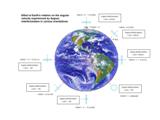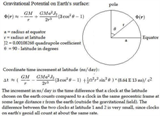Interferometer Webapps and Experiment Simulators.
1) Interactive Michelson Interferometer
 |
A
webapp that allows one to simulate the Michelson and Morley experiment
and set a variety of conditions to determine what amount of fringe
shift would be detected when the device is rotated from 0 to
90
degrees. Variables include Lorentz contraction, refractive index,
relative speed of frame (ether wind), path length, and
wavelength. Uses equations developed in "The Premise for
Comparing Ether Theory to Relativity Theory" in the Theory and
Experimental Tests section.
|
2) Interactive Hoek Interferometer
 |
A
webapp that allows one to simulate the Hoek experiment and set a
variety of conditions to determine what amount of fringe shift would be
detected when the device is rotated from 0 to 90 degrees.
Variables include Lorentz contraction, refractive index, relative speed
of frame (ether wind), path length, and wavelength. Uses
equations developed in "The Premise for Comparing Ether Theory to
Relativity Theory" in the Theory and Experimental Tests section.
|
3) Interactive
Michelson-Gale Interferometer
 |
A webapp
that allows one to simulate the Michelson-Gale experiment. The original
parameters are pre-loaded. The dimensions of the experiment, the
latitude, the light wavelength etc. can be adjusted to see they effect
the experimental outcome.
|
4A) Interactive
Simple Sagnac Interferometer /Fibre-Optic Gyroscope (FOG)
 |
A
webapp that allows one to simulate the Sagnac effect. Shows how the
propagation time for each beam on the rotating platform can be
calculated
using simple Galilean addition of velocities, and how in the
frame of the rotating observer the velocity of each beam differs by the
rotation velocity. |
4B) Interactive
Complex Sagnac Interferometer /Fibre-Optic Gyroscope (FOG)
 |
A
webapp that allows one to simulate the Sagnac effect. The original
parameters of the Michelson-Gale experiment are pre-loaded. Various
parameters can be adjusted to see how rotation, translation, and the
movement of the earth affect the readings of the interferometer. |
5) Interactive
Hafele and Keating Time Dilation Experiment
 |
A
webapp to simulate the around the world time dilation experiment
using clocks flown on planes westbound and
eastbound. The
time lost or
gained on each clock it determined with respect to a clock
that remains on the ground at the starting point. The simulator can
vary parameters such
as the altitudes the clocks are flown at, the
latitude of the path over the surface of the earth, and the total trip
time for each flight. The individual
terms (velocity, Sagnac and
height) are calculated and then shown separately and as a net time
gain/loss by each clock.
|
6) Interactive
Gravitational Potential and Coordinate Time Increment on Earth's Oblate
Geoid
 |
A
webapp to simulate the textbook calculation of gravitational potential
on the earth's surface, and the coordinate time increment of
clocks at different latitudes at sea level.
|
7) Interactive
Gravitational Potential and Coordinate Time Increment on Earth's Oblate
Geoid 1
 |
A more
advanced webapp simulation also comparing time dilation effects on
moving clocks at velocities and heights over the earth's
surface,
similar
to the Hafele and Keating experiment. |
8) Interactive Esclangon Telescope Simulator.
 |
A webapp
that allows one to simulate the Esclangon
Experiment. The
webapp allows one to adjust the mirror angles and hypothetical
ether wind speed. The vertical image displacement in
the
telescope on rotation is then calculated assuming that
the mirrors
would experience a Lorentz contraction in the direction of the ether
wind. See article 5) in the "Our Experiments and
Videos"
section for additional details.
|
9) One
Laser One-Way Speed of Light Interferometer Simulator.
 |
A webapp
that allows one to simulate a one-way speed of light experiment
using one laser. This demonstrates how the fringe
shift
that arises due to a standing wave moving with
respect to a
sensor in an interferometer that is rotated
through an
aether wind will be cancelled by the frequency shift in the laser clock
due to a mechanical time dilation effect predicted by Lorentz.
|
10) Two
Laser One-Way Speed of Light Interferometer Simulator.
 |
A webapp
that allows one to simulate a one-way speed of light experiment using
two lasers. This demonstrates how the fringe shift that should
arise due to differening path lengths and the laser beams crossing from
parallel to perpendicular to an aether wind, will be cancelled by the
frequency shift in the laser clock due to a mechanical time dilation
effect predicted by Lorentz.
|
11) Local
Time to Sidereal Time Converter
 |
A webapp
that allows one to calculate the sidereal time value for any local time
value, knowing the date, local time, and longitude of the observer.
Also calcuates the Julian date.
|
12) Shamir and Fox Experiment
Simulator
 |
A
webapp demonstrating how refractive index has no effect on the measured
speed of light in a Michelson interferometer. This simulator also
breaks out the apparent time dilation along each arm, showing how it
deviates from the average time dilation at the detector.
|
13) Kennedy
Thorndike Experiment Simulator
 |
A
webapp demonstrating how orientation with respect to sidereal space and
arm length has no effect on the measured speed of light in a Michelson
interferometer. This simulator also breaks out the apparent time
dilation along each arm, showing how it deviates from the average time
dilation at the detector. Time dilation is shown to be not
just a
velocity effect but also an effect which depends on
orientation
with respect to velocity.
|
14) Rotating
Triangle Interferometer
 |
A
webapp demonstrating how light beams counter-travelling around
a
closed path will always show the same measured speed of light
even
if the interferometer is moving at a relatively high velocity through
space. Includes a number of adjustable parameters
|
15) GPS Propagation Range Simulator
 |
A
webapp demonstrating why it is that our high speed translational motion
through space is never detected by GPS range measurements, even though
the much smaller rotational velocity of the earth is easily detected
via the Sagnac effect. In explaining this effect via apparent time
dilation of the GPS transmitter, the necessity for trying to explain
this issue using a dragged ether hypothesis becomes unnecessary.
|

|
We
attempt to show why terrestrial aberration does not occur in a
Michelson interferometer. The light beams are shown to arrive at the
interferometer detector perfectly parallel despite any velocity, due to
a physical Lorentz contraction of the apparatus and the beamsplitter.
|
|










